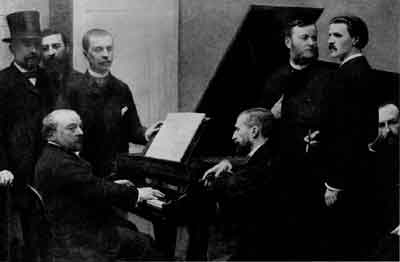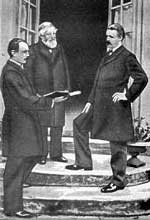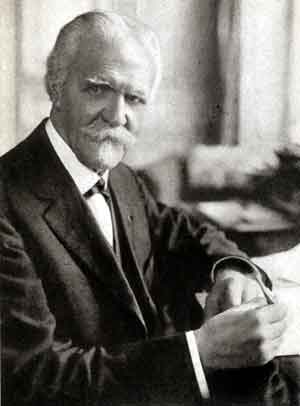|
Vincent
d’Indy
By Don Robertson
Background
The
importance and magnitude of the artistic movement that
took place in France during the last decades of the 19th
Century cannot be denied. It created a transformation in
the evolution of art, poetry and music.
To
better grasp what was taking place in France at this time,
it is necessary to understand the influence that the music
and writings of Richard
Wagner
had upon many young creative artists living and working in
Paris. The first performance of Wagner’s revolutionary
work Tannhaüser that took place in Paris in 1861
created such a scandal among the entrenched establishment
that another Wagner music drama would not be staged in
Paris until 1887 (a performance of Lohengrin
directed by Charles Lamoureux, with the help of Vincent
d’Indy). Despite the lack of a French Wagnerian staging
for twenty-six years, French artists, composers, and poets
listened to piano reductions of Wagner’s music and
consumed his writings.
The world premiere of Wagner’s fifteen-hour-long ring
cycle took place in his new theater in Bayreuth, Germany
in August 1876, and a handful of French composers made
pilgrimages to this almost holy shrine. Upon returning,
they talked and wrote profusely about what had taken
place; Saint-Saëns, for example, wrote five articles
about the Bayreuth experience and Catulle Mendès three. A
few years after, concerts of Wagner’s music began to
take place in Paris. Those at the Eden Theater, conducted
by Charles Lamoureux, resembled holy services, to which
painters like Blanche and Valloton, poets and writers such
as Mallarmé and Proust, and many musicians and composers
flocked.
By the mid-1880s, the music and thinking of the
now-deceased Wagner had ignited nearly the entire
intellectual and artistic movement in Paris, including the
most distinguished and the most gifted artists, writers,
and composers. Some, in addition to attending the Eden
Theater concerts, made pilgrimages to Bayreuth. The effect
of Wagner’s music was deeply felt. Ravel and Chabrier
had similar experiences during performances of the prelude
to Tristan und Isolde: the music so moved them that
they broke into tears and sobbed. Composer Guillaume Lekeu
fainted during an 1889 Bayreuth performance, and Vincent
d'Indy broke down and wept while experiencing the death of
Siegfied in Götterdamerung.
Wagner's influence on French music was overwhelming.
Testimony to this were Wagnerian-inspired music dramas,
including Debussy’s Pelléas et Mélisande,
Bruneau's Le Rêve, Chapentier’s Louise,
Reyer’s Sigurd, Chausson’s Le Roi Arthus,
and d’Indy’s Fervaal. Additionally, composers
such as Franck, Gounod, Lekeu, Bizet, Massenet, Saint-Saëns,
Duparc, Fauré, Delibes, and Ravel were all inspired by
Wagner, as well as the poets and writers Villiers de
l’Isle-Adam, LaForgue (who influenced Eliot and Pound),
Valéry, Colette, Dujardin, de Nerval, Gautier, Mallarmé,
Proust, Verlaine, Ghil, Baudelaire, Morice, and Vignier.
Among painters were Blanche, Valloton, Gauguin, Cézanne,
Bazille, Fantin-Latour, Whistler, and Doré.
Vincent
d'Indy
Vincent d’Indy (1851-1931) is
an important, but perhaps not a great, composer who, unfortunately for
contemporary ears, has fallen into near obscurity. A single
work, the beautiful Symphonie
Cévenole
(Symphony on a French Mountain Air), identifies the composer
today. He was born and raised in Paris, and at an early age
began preparing for a career in music. In 1872, he enrolled
in Cesar Franck’s organ class at the Conservatoire, and
soon Franck, who taught a group of young French composers at
his home, became d’Indy’s mentor and composition
teacher. D’Indy recognized the genius of the man that many
at the Conservatoire considered only an organ teacher.
|

"Autour
du piano" painting by Henri Latour, 1885
Musée d'Orsay
Emmanuel
Chabrier at the piano.
From left to right : Adolphe Jullien (critic),
Boisseau (violinist at the Opera),
Camille Benoit (art historian), Edmond Maitre (érudit),
Lascoux (magistrat),
Vincent d'Indy, A. Bigeon (romancier et critique) |
During the great artistic revival that took place in Paris
during the second half of the 19th century when
“impressionist” painting, new music, and symbolist
poetry came into the world, composers, painters, and poets
alike gathered together to discuss and share art. It was at
meetings such as the soirées that Chausson,
Saint-Saens, and the poet Mallarmé held weekly in their
homes, that some of the greatest creative minds of the time
(such as Degas, Monet, Renoir, Rodin, Franck, Gide, Fauré,
Duparc, d’Indy, Debussy and Chabrier) discussed art and
music.
In
addition to his great admiration for Wagner,
d’Indy had, as had Wagner himself, discovered and
developed a tremendous love for the sacred music of the
great composers of the 16th century--Gallus,
Lassus, Palestrina,
Josquin des
Pres, and Victoria--and for Gregorian chant: a forgotten
body of work that constitutes one of the greatest
outpourings of music the world has produced. Beginning in
1890, d’Indy, realizing this, began working with fellow Franck
student Charles Bordes, on what became the center of a
powerful revival of sixteenth-century sacred music in Paris.
In the following year, d’Indy helped form the Société
des Chanteurs de Saint-Gervais to help restore this great
music to what he felt was its rightful place in society.
Members of Paris’s artistic community, including Debussy
and Mallarmé who were regulars, frequented the Société’s
concerts of the music of Gallus, Palestrina, and Victoria.
|
The
Three Founders of the Schola Cantorum
in 1894 :
Charles
Bordes,
Alexandre Guilmant
et Vincent d'Indy. |

|
D’Indy’s musicial interests distanced him from the
formal instruction that was being served at the
Conservatoire, and in 1896, in conjunction with Bordes and
Guilmant, he founded a new music school, the Schola Cantorum,
becoming its first director. The mission of the Schola was
to forge a return to the tradition of Gregorian chant and
music in the style of Palestrina, with new music inspired by
these traditions, and to reform the system of music
education then in place in French schools. D’Indy wrote a
complete course of composition that started with Gregorian
chant and continued historically through to the music of the
composers of his time, as d’Indy was in complete support
of both Debussy and Ravel.
D’Indy remained the director of the Schola Cantorum until
his death in 1931. The Schola remains today a highly
regarded institution and has trained many composers and
musicians, beginning with d’Indy’s own students, Roussel
and Satie, and including, among others, Albeniz, Canteloube,
Célibidache, Duruflé, Gulmant, Landowska, Langlais,
Messiaen, Milhaud, Turina, Varese and Vierne.
While
many composers followed Arnold
Schönberg on the road to discordant harmonies and
atonality, some did not. Among the detractors was Vincent
d’Indy. According to Andrew Thomson, in his book Vincent
d'Indy and His World, d’Indy called Schönberg "a
madman who teaches nothing except that you should write
everything that comes into your head...His work..is no more
than a mass of meaningless notes." On another occasion,
Honegger suggested to d'Indy that Schoenberg's music was to
be read, rather than to be heard, to which d'Indy replied:
"These noises don't interest me on paper any more than
they do in the atmosphere." He had no sympathy for
discordant music. He considered "modernist" Edgard
Varese, who was a student at the Schola Cantorum, a dishonor
to the teaching of the school.
But
now that the discordant storm clouds of twentieth century
music have passed and a new century has arrived, orchestras
and lovers of great music are looking for new music, and as
interest grows in the work of some of the composers whose
recognition was lost in the confusion of atonality, Vincent
d’Indy begins to surface on radar screens. 21st Century
concert halls are due for a reform, and first in line should
be the works of Cesar Franck
and the group of composers that he nurtured, the most
important being Ernest Chausson,
Vincent d'Indy and Henri DuParc.
© 2005 by Rising World Entertainment
DoveSong
Articles
Analysis of d'Indy Symphonic Works
by Don Robertson
Jour
d'été à la Montagne
An analysis by Don Robertson
Souvenirs
An analysis by Don Robertson
Istar
An analysis by Don Robertson
Tableau
de Voyage
An analysis by Don Robertson
Web Sites
Biography (en francais)
Biography
(en francais)
D'Indy Website
Great
bio and catalogue des oeuvres (francais)
Selected
Compositions
Various
orchestral works
Symphony
on a Mountain Air and Symphony No. 2
Symphony
No. #3 and two symphonic works
Diptyque
Méditarranéen
Books
about d'Indy
Vincent
d'Indy and His World
by Andrew Thomson
Vincent
d'Indy
by Norman Demuth
Vincent
d'Indy
by Leon Vallas
Champion
of Classicism
by Norman Demuth
Books
by d'Indy
Beethoven, par
Vincent d'Indy
Librarie Renouard, 1911
Wagner, par
Vincent d'Indy
Librarie Delagrave, 1930
César Franck by Vincent d'Indy

d'Indy
in 1931
|
En
musique, l’agent principal de l’oeuvre est ce que nous
appelons thème
ou idée. On peut en donner la définition suivante: l’idée
musicale est constituée au moyen d’éléments sonores,
fournis par l’imagination,
choisis par le coeur,
mis en ordre par l’intelligence.
From
the book "Beethoven"
by Vincent d'Indy
|
|

